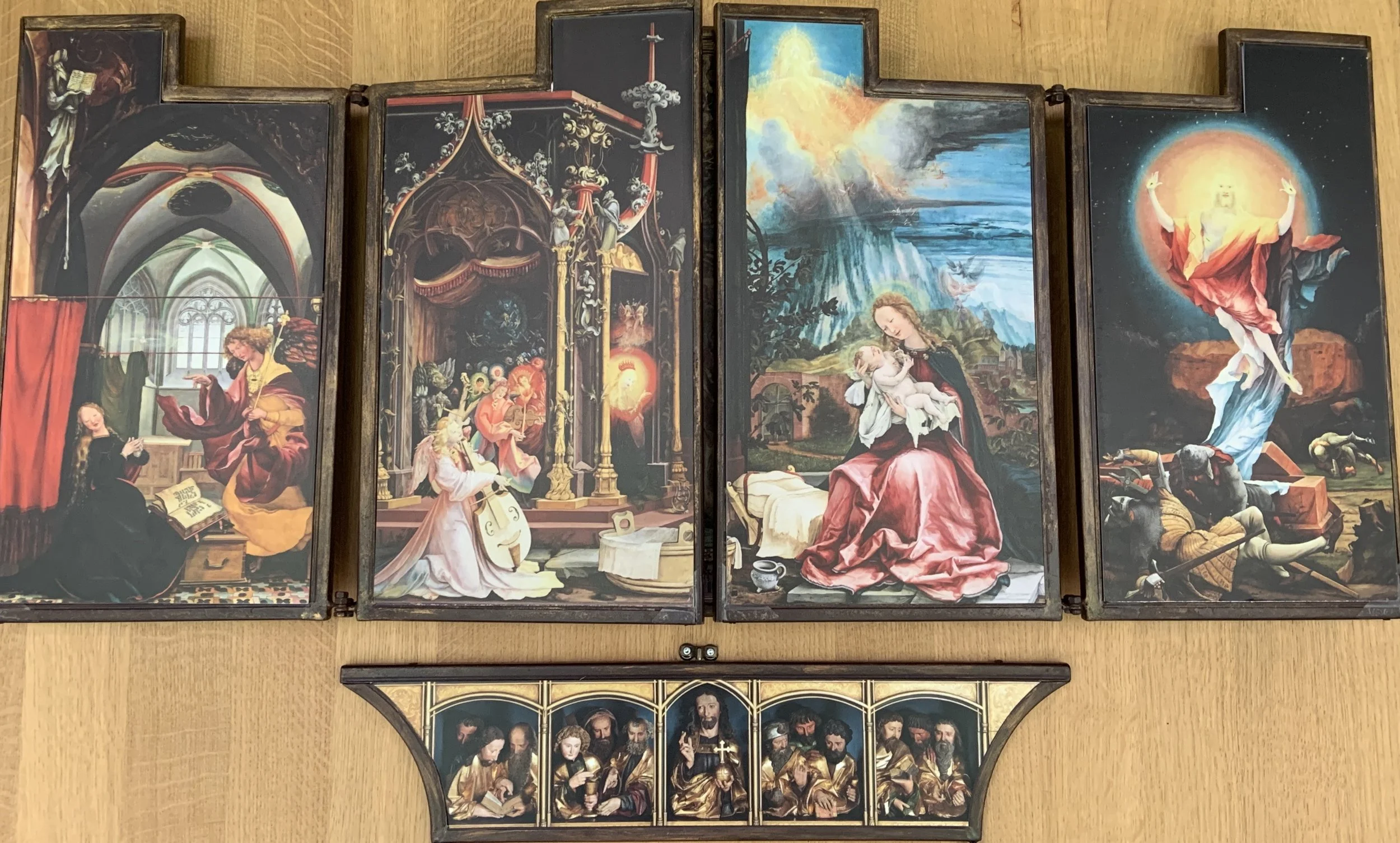The Isenheim Altarpiece
/It’s three sections were designed and built for the Monastery of St. Anthony in Isenheim, France to help relieve the suffering of the hospital’s patients who had St. Anthony’s Fire. St. Anthony’s Fire is a debilitating disease called ergotism, similar to shingles, caused by eating the fungus on contaminated grain, which affects the entire body. It begins with a burning sensation starting in the outer extremities and progresses across the body leaving scars and sores. One temporary treatment was the amputation of a leg or arm in an attempt to stop the flow of the disease.
The opening view of the Issenhiem Altarpiece. The individual panels are explained elsewhere, except the painting beneath. Here the crucified Christ is dead. His body has been cleaned and prepared for burial in the tomb. It subtly implies that there is an end to the pain and suffering inflicted upon us. This was the normal view of the triptik. It was opened to the other views only on certain holy days.
As we made our through the Unterlinden Museum I think the first thing which impressed me was the number of groups of school children ranging from late middle school to high school. When we finally reached the room holding the Issenhiem Altarpiece we discovered this was their destination. They stood and sat around each panel listening intently to the guide as explanations were given about the design and building of each panel.
Today one of the primary aspects of medical treatment is managing pain. When my friend passed away a few years ago from cancer his last few days were spent in hospice. The job of the nurse was to make sure he rested as peacefully as possible, which actually came down to controlling his pain through medication. Five hundred years ago the medication option was unavailable. One method of support was to remind sufferers that others had suffered also, and that the suffering does come to an end. And so we have the Isenheim Altarpiece.
The statement from the Isenheim Altarpiece is simple and straight forward. Jesus suffered. He was arrested, tried and found guilty of crimes against the state. He was sentenced to crucifixion. He was whipped with 40 lashes obliterating the skin of his back leaving bare muscle. He carried his cross to the crucifixion site on the hill of Golgotha. He was nailed, hands and feet, to the cross. He died. A spear was thrust into his side to make sure he was dead.
The second view of the triptik shows four scenes. On the far left archangel Gabriel tells the Virgin Mary she has been chosen by God to be the mother of Jesus. In the center panel there are two nativity pictures rolled into one concept. On the left are the angels and spirits joined with music and harmony in a surreal magical setting looking at Mary and the Christ child. On the right, Mary smiling at the newborn baby in a pastoral setting with a background filled with joyous spirits in the air celebrating the child’s birth. On the right is a glorious celebration as Jesus ascends into heaven. Below are the sculpted images of Jesus with his twelve apostles.
The Isenheim Altarpiece brings all of this to mind. It reminded those suffering in the monastery that others had suffered, but their suffering had ended, and there was release. In this hope these sufferers would find release.
In the 1500s, the time of the Isenheim Altarpiece, there was no real treatment. All that was available for those who contacted the disease was to made as comfortable as possible.
Care was what the Monastery of St. Anthony specialized in. St. Anthony and St. Sebastian were the noted Saints for healing at the monastery. Calling on the two saints, the Antonine monks were well known for their care of people with skin diseases and plague. St. Anthony was known as a healer and reached out to the victims of St. Anthony’s Fire. St. Sebastian was known for the care and healing of victims of the plague.
The third view of the altarpiece is the work of sculpture Nikolaus of Haguenau. In the center sitting on his throne is St. Anthony and on either side are St. Augustine (his left) and St. Jerome (his right). At his feet, the locals bring gifts, one of which is Guy Guyers who commissioned the altarpiece. In the right panel, St. Anthony is plagued by demons, and in the lower left corner is one of the victims of St. Anthony’s Fire, his arm rooted to the elbow and sores covering his body. In the left panel St. Anthony visits with the Apostle Paul. Below are Jesus and the apostles at the Last Supper.



